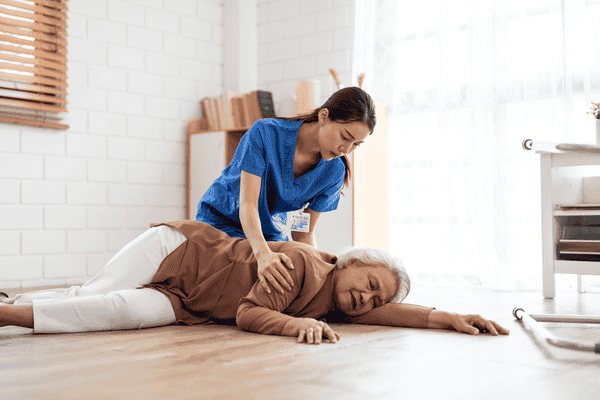Have you ever wondered about the different types of strokes that can affect our beloved seniors unexpectedly, changing their lives in an instant? From the common ischemic stroke caused by blood clots to the less frequent hemorrhagic stroke due to blood vessel ruptures, each type presents its own challenges and outcomes.
In our upcoming blog, “Types of Strokes in the Elderly: Causes, Symptoms, and Treatments,” we delve deep into this critical topic that touches many families worldwide. Here’s what we’ll cover to shed light on this vital subject and empower you with knowledge:
- Unveiling the various types of strokes prominent in the elderly population, from basal ganglia to thalamic strokes.
- Understanding the underlying causes and identifying warning signs to ensure early intervention and care.
- Exploring the available treatment options and considerations, highlighting the importance of prompt medical attention for optimal outcomes.
Get ready to embark on a journey to discover the intricacies of strokes in the elderly, understanding their prevalence, symptoms, and life-changing implications. Let’s navigate this important healthcare landscape together, empowering ourselves and our loved ones with valuable insights and awareness.
Introduction
Meet Mary, an energetic grandmother of six who loves spending her weekends baking cookies and gardening. One evening, while playing a board game with her grandchildren, Mary suddenly felt her face droop on one side, and she couldn’t articulate her words clearly. Her family, recognizing these alarming signs, called for help immediately. This swift action changed the course of her life. Mary had suffered a stroke.
Strokes are a significant health concern, particularly among the elderly population. Understanding the different types of strokes is crucial for elderly individuals and their caregivers. By gaining insights into the causes, symptoms, and available treatments, we can better navigate the challenges associated with strokes in older adults.
Strokes occur when there is a disruption of blood flow to the brain, leading to the death of brain cells. In the elderly, strokes can have severe consequences, including long-term disability, cognitive impairment, and even death. It is therefore essential to familiarize ourselves with the various types of strokes to recognize the signs and seek prompt medical attention.
By recognizing the symptoms early and understanding the appropriate treatment options, we can significantly improve the outcomes for elderly individuals who experience a stroke. In this article, we will explore the three main types of strokes that commonly affect the elderly population: transient ischemic attack (TIA), ischemic stroke, and hemorrhagic stroke. We will delve into the causes, symptoms, and risk factors associated with each type, equipping you with valuable knowledge to protect your loved ones and promote their well-being. So, let’s begin our exploration of strokes in the elderly by examining these different types.
Types of Strokes
Transient Ischemic Attack (TIA)
A transient ischemic attack, often referred to as a “mini-stroke,” is a temporary disruption of blood flow to the brain. Although the symptoms are similar to those of a stroke, they typically last only a few minutes and do not cause long-term damage. TIAs are warning signs of a potential future stroke and should never be ignored.
Causes:
- Temporary blockage of blood flow due to a blood clot or other debris.
- Fatty plaque lodging in a blood vessel and temporarily restricting blood flow.
Symptoms:
- Sudden weakness or numbness on one side of the body.
- Slurred speech or difficulty understanding others.
- Loss of balance or coordination.
- Temporary vision changes, such as blurred or double vision.
Risk Factors:
- Older age, especially individuals over 55.
- History of TIAs or previous strokes.
- High blood pressure, diabetes, or heart disease.
- Smoking, excessive alcohol consumption, or illicit drug use.
- Being overweight or leading a sedentary lifestyle.
Ischemic Stroke
Ischemic strokes, the most common type of stroke, occur when a blood clot or other obstruction blocks blood flow to a part of the brain. This interruption in blood supply leads to the death of brain cells and potentially significant long-term damage.
Causes:
- Blood clots forming in narrowed or blocked arteries (thrombotic stroke).
- Blood clots traveling from other parts of the body and lodging in brain arteries (embolic stroke).
Symptoms:
- Sudden weakness or paralysis, usually on one side of the body.
- Difficulty speaking or understanding speech.
- Vision problems, such as blurred or darkened vision.
- Severe headache, often accompanied by nausea and vomiting.
Risk Factors:
- High blood pressure, especially when uncontrolled.
- Smoking or exposure to secondhand smoke.
- Diabetes and high blood cholesterol levels.
- Atrial fibrillation or other heart rhythm disorders.
- Certain medical conditions, such as sickle cell disease or autoimmune diseases.
Hemorrhagic Stroke
Hemorrhagic strokes occur when a blood vessel ruptures or leaks in the brain, leading to bleeding and pressure on brain tissues. This type of stroke is less common but often more severe than ischemic strokes.
Causes:
- Weakening or abnormality in blood vessel walls (aneurysm or arteriovenous malformation).
- High blood pressure causing blood vessels to rupture.
- Blood-thinning medications, such as warfarin, increasing the risk of bleeding.
Symptoms:
- Sudden and severe headache, often described as the worst headache of one’s life.
- Nausea, vomiting, and dizziness.
- Weakness or numbness on one side of the body.
- Difficulty speaking, slurred speech, or confusion.
Risk Factors:
- High blood pressure, especially when uncontrolled.
- Family history of aneurysms or bleeding disorders.
- Aging, as blood vessels become weaker over time.
- Substance abuse, especially cocaine or amphetamine use.
- Previous history of brain aneurysms or hemorrhagic stroke.
Early Intervention and Treatment Options
Early intervention is crucial in the management of strokes. Recognizing the symptoms and seeking immediate medical attention can significantly improve outcomes.
Transient Ischemic Attack (TIA) Treatment:
- Medication: Blood thinners and antiplatelet drugs are often prescribed to prevent future strokes.
- Lifestyle Changes: Adopting a healthy diet, regular exercise, and quitting smoking can reduce stroke risk.
- Monitoring: Regular check-ups with a healthcare provider to monitor and manage risk factors.
Ischemic Stroke Treatment:
- Thrombolytics: Medications like tPA (tissue plasminogen activator) can dissolve clots if administered within a few hours of symptom onset.
- Mechanical Thrombectomy: A procedure to remove clots from the brain’s arteries.
- Rehabilitation: Physical, occupational, and speech therapy to recover lost functions.
Hemorrhagic Stroke Treatment:
- Surgery: Procedures to repair damaged blood vessels and reduce pressure on the brain.
- Medication: Drugs to control blood pressure, prevent seizures, and reduce brain swelling.
- Rehabilitation: Similar to ischemic stroke rehabilitation, focusing on regaining physical and cognitive abilities.
Conclusion
Understanding the different types of strokes, their causes, symptoms, and risk factors is essential for informed decision-making and timely medical intervention. If you or someone you know experiences any stroke symptoms, always seek immediate medical attention to optimize chances of survival and minimize potential long-term effects.
Mary’s story is a stark reminder of how quickly life can change. By educating ourselves and staying vigilant, we can protect our loved ones and ensure they receive the care they need in critical moments. Let’s continue to spread awareness and knowledge about strokes in the elderly, empowering our communities to act swiftly and effectively when it matters most.









I couldn’t resist commenting
I¦ve recently started a web site, the information you provide on this site has helped me greatly. Thank you for all of your time & work.
Some really interesting details you have written.Assisted me a lot, just what I was searching for : D.
I love the efforts you have put in this, thankyou for all the great articles.
It is appropriate time to make a few plans for the future and it is time to be happy. I have learn this post and if I may I wish to suggest you few attention-grabbing issues or suggestions. Perhaps you can write subsequent articles referring to this article. I desire to read even more issues approximately it!